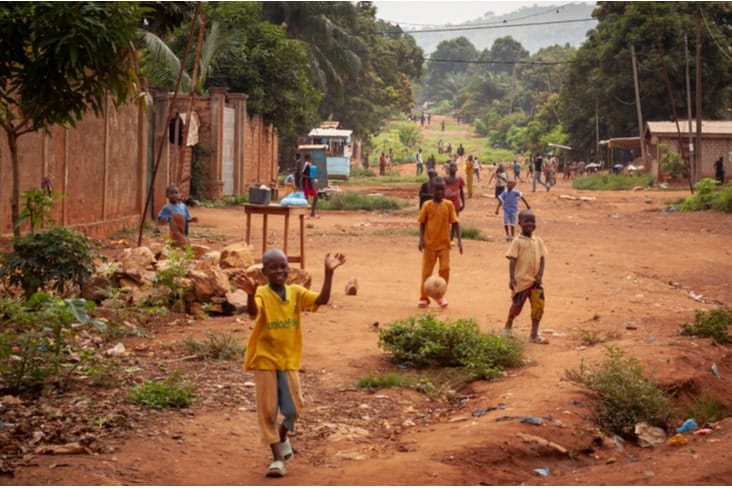From the world’s hungriest country to superb star-gazing, these are the most interesting facts about the Central African Republic.

Fast facts
Official name: Central African Republic
Capital city: Bangui
Population: 5,650,957
Area: 622,984 sq km
Major languages: French, Sangho
Time zone: UTC+1 (West Africa Time)
Interesting facts about the Central African Republic
1. The Central African Republic (CAR) is a landlocked country in Central Africa. A landlocked country is completely enclosed by land with no access to the open sea.
2. The Central African Republic has been settled for at least 8,000 years. Polished flint and quartz tools have been found that are at least 8,000 years old.
3. European and Arab slave traders exploited the region throughout the 17th, 18th and 19th centuries with tens of thousands of people forcibly removed and sent to slave markets in Egypt, Turkey and the Atlantic coast, where they were transported to the Americas.
4. France annexed the region in the 1880s as they took control of what would become French Congo (later French Equatorial Africa). This included Ubangi-Shari (Central African Republic), Chad, Gabon and the Middle Congo (the Republic of the Congo).
5. In 1960, the Central African Republic gained independence with David Dacko the country’s first president.

6. The Central African Republic has experienced widespread instability since its independence with multiple coups and internal conflicts.
7. The Central African Republic has seen significant violence since 2013 due to fierce clashes between armed groups. This has created over 600,000 refugees outside the country and displaced a further 600,000 people in the country.
8. According to the UK Foreign Office, the Central African Republic is one of 17 countries deemed to be entirely unsafe for tourists to visit.
8. The world’s second-largest rainforest, the Congolese Rainforest, is part-located in the Central African Republic. The Congolese Rainforest spans six countries: Cameroon, Gabon, Congo, the Democratic Republic of the Congo, Equatorial Guinea and the Central African Republic.
9. According to “The New World Atlas of Artificial Night Sky Brightness”, the Central African Republic, along with Chad and Madagascar, are the countries least affected by light pollution.
10. The Central African Republic is home to the ethnic group of Pygmy people, known for their short stature – typically under five feet tall. The word “Pygmy” comes from the Greek for “dwarfish”, although Pygmys are conventionally proportioned.

11. The Central African Republic is the world’s second-poorest country when measured by GDP per capita based on purchasing power parity (PPP).
12. In 2023, the Central African Republic was ranked as the world’s second hungriest – or undernourished – country. It was the only country classified as “alarming” at 42.3%
13. The Central African Republic has one of the world’s lowest life expectancy of just 54 years.
14. The Central African Republic is amoung the countries with the lowest CO2 emissions when measured by CO2 per capita.
15. The Central African Republic has a unique flag with horizontal stripes of blue, white, green and yellow, all overlapped by a central red vertical stripe. There is also a yellow star is in the upper left corner.

16. The flag was designed by the CAR’s first prime minister, Barthélemy Boganda, who wanted the flag to reflect his belief that France and Africa must work together. The flag combines the French tricolour with the pan-African colours. Blue represents liberty, grandeur and the sky; white represents purity, equality, and candour; green represents the forests of the nation; yellow represents its savannas; red is for the blood of all humankind.
17. The Central African Republic holds vast natural resources, including diamonds, gold, oil, timber and immense amounts of arable land and hydropower.
18. The Central African Republic is exceptionally rich in biodiversity, with many rare and endemic species including gorillas, elephants, hippos, lions, cheetahs, leopards, rhinos and crocodiles.
19. As of 2002, there were at least 208 mammal species, 698 bird species and over 3,600 plant species in the Central African Republic.

20. The Central African Republic is also home to 597 identified species of butterflies.
21. The Central African Republic has one UNESCO World Heritage Site entirely within its borders, the Manovo-Gounda St Floris National Park. It is known for its wide variety of species including rhinos, elephants, cheetahs, leopards, wild dogs, gazelles and buffalo.
22. The Dzanga-Sangha (Dzanga-Ndoki) National Park in the Central African Republic is also part of the UNESCO-listed Sangha Trinational. The site is made up of three contiguous national parks in Cameroon, Central African Republic and Congo and is home to huge concentrations of elephants and gorillas.
23. The Central African Republic is among the 10 most dangerous countries in the world according to the International SOS Travel Risk Map. It has been assessed as carrying an ‘extreme travel security risk’.
Every effort has been made to verify these facts about the Central African Republic. However, if you find an error or have any questions, please contact us.
